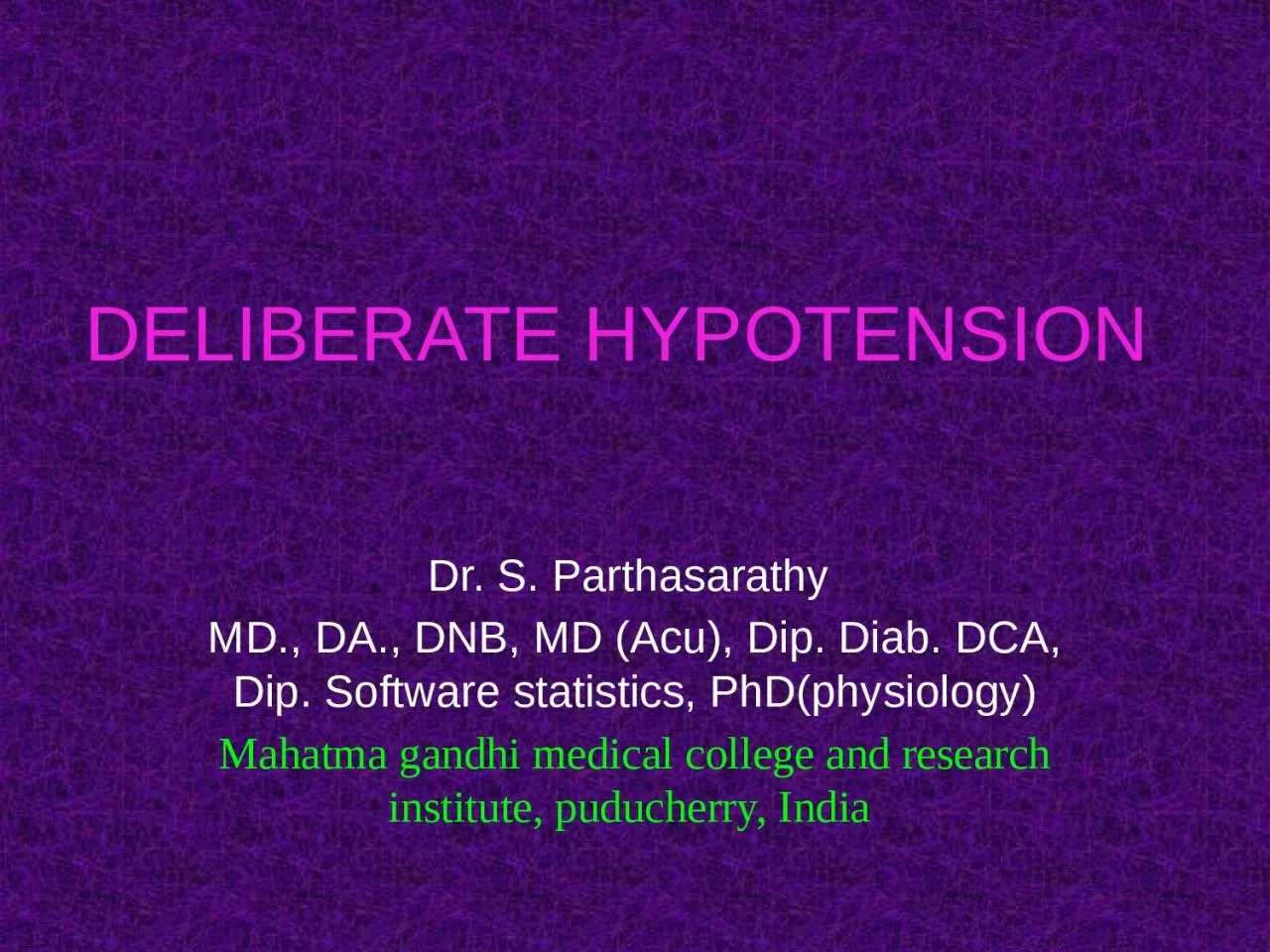

Parthasarathy MD DA DNB MD Acu Dip Diab DCA Dip Software statistics P hDphysiology Mahatma gandhi medical college and research institute puducherry India ID: 934394
Download Presentation The PPT/PDF document "DELIBERATE HYPOTENSION Dr. S." is the property of its rightful owner. Permission is granted to download and print the materials on this web site for personal, non-commercial use only, and to display it on your personal computer provided you do not modify the materials and that you retain all copyright notices contained in the materials. By downloading content from our website, you accept the terms of this agreement.
Slide1
DELIBERATE HYPOTENSION
Dr. S.
Parthasarathy
MD., DA., DNB, MD (
Acu
), Dip.
Diab
. DCA, Dip. Software
statistics,
P
hD(physiology)
Mahatma
gandhi
medical college and research institute,
puducherry
, India
Slide2DEFINITION
Reduction
of the
systolic
blood
pressure to
80-90mmHg
Reduction
of
mean
arterial
pressure (MAP) to
50-65
mmHg
30%
reduction
of
baseline
MAP
DRUG. 2007; 67 (7): 1053-76
Slide3Indications
Expected major blood loss
scoliosis,
revision hip surgery,
pelvic malignancies,
major vessel surgery,
reconstructive spinal surgery
Slide4Indications
Complex
neuro
surgery
Intracranial , spinal
meningioma
,
AV malformations
Pituitary surgeries
Slide5Indications
Microsurgery
Plastic,
Middle ear,
FESS
Vessel grafts
Slide6Indications
Intra ocular surgery
Choroid
Vitrectomy
INDICATIONS
may reduce blood loss or provide a bloodless field
Slide7SPINE
S
= SPINAL
P
= PITUITARY, PELVIC, PLASTIC
I
= INTRACRANIAL, INTRAOCULAR
N
=NEURO, NEUROVASCULAR
E
= EAR, ENDOSCOPIC SINUS
Slide8Get idea !! Blood flow to site stopped with preserved blood flow to vitals
Slide9Contraindications
Ischemic stroke
SAH,
Untreated hypertension
PVD,
Renal, liver impairment
IHD, fixed Cardiac output states
Hypovolumia
,
Pregnancy, glaucoma
Slide10Essence to know -- MAP
MAP = cardiac output
˟
TPR
cardiac output = heart rate
˟
strᴏke
volume
Beta blockers Decrease preload and depress contractility
Vasodilators
Slide11Techniques which reduce blood loss but not deliberate hypotension
Local with adrenaline
Tourniquet
IPPV
PEEP
Position
Spinal & Epidural
Slide12Position and bloodless fields
BP APP.
Slide13Technique
Suitable patient
↓↓
BP OK
Position
↓↓
BP OK
Isoflurane
slowly withdraw each
↓↓
BP OK
↑↑
First line
hypotensives
→ 2
nd
line
hypotensives
BP OK
Slide14Technique
Keep MAP at
55 to 60
mm Hg
WHY ?
Auto regulation
of Coronary and cerebral blood flow stops at MAP at
50 to 55 mm
Hg
Slide15AGENTS
1. Neurological depressants
volatile
anaesthetics
, IV
anaesthetics
.
2. Vasodilators
Direct : SNP, NTG, Adenosine, PGE1,
Hydralazine
Indirect :
Trimethaphan
(
Intravenous infusion, 3 to 4 mg per minute)
3.Cardiac depressants
: GA
inh
. Agents, β blockers, CCBs
Slide16By simple method
Decrease systolic to
preop
diastolic to a maximum
i.e
Preop
BP : 130/85 mmHg
Come down systolic
upto
85 intra op
Slide17Inh. agents
Isoflurane
is ideal
2 MAC
SVR decrease without myocardial depression
Inh
. of
baroreceptor
reflexes thro
anaesthetic
action
Halo OK but think of
brady
and myocardial depression
Slide18Enflurane
– potent myocardial depression and possible ill effects on
splanchnic
perfusion
No to
hypotensive
use
Inh
agents – think if cranium is not opened as they may raise ICT
Slide19SNP
Onset 30 sec, peak 2 min.
1 to 1.5
mic
/Kg /min
Toxicity due to cyanide as metabolite – common after 8
mic
/Kg /min
Systemic and pulmonary
vasodilation
Young patients tolerant –
baroreceptors
and
caatecholamines
Elderly be careful.
Slide20NTG
More effect on capacitance vessels
Better in IHD patients
Action a little delayed : 2 -10 min.
Reflex tachycardia
Slide21Adenosine
May have effect on his bundle and produce conduction disturbances
Adenosine 0.14 mg/kg/min
Ideal to give in central vein.
Hydralazine
Gradual and prolonged action
Slide22Beta blockers
Labetolol
--both alpha and beta
time to recovery ??
Labetolol
-4 hours Vs
Esmolol
- 9.2 minutes
Slide23Others
CCBs
Nicardipine
The
infusion dose
was 1.14 ± 0.45 µ
g·kg·min
PGE1-
doses < 0.01 mcg/kg/min
Used in Japan for neurosurgeries successfully
Slide24Monitoring
Routine monitoring, ECG, EEG, ETCO2 + urine output
USE IBP
If persistent use rapid acting drugs are planned
Or
if systolic is = or << 70 mmHg
Slide25Combination
Position +
iso
+
Esmolol
or NTG
Local adrenaline +
iso
Trimethaphan
+ NTG
Beta blockers + NTG
Slide26Some tips
Oral
propranolol
40 mg
tds
followed by
hypotensive
anaesthesia
Oral ACE inhibitors followed by
hypotensive
anaesthesia
Why ??
Slide27DELIBERATE HYPOTENSION
Activates
Catecholamines
(oral
propanolol
)
Rennin
angiotensin
mechanism
(oral
captopril
)
Slide28Complications
Inadequate
Dosage, tolerance
Excessive
Maintain IV volume status ,
ECG,
dosage
Slide29Complications
Cerebral
thrombosis
0.1 – 0.2 %
Coronary
artery
thrombosis
0.3 – 0.7 %
Renal
failure
0 – 0.2 %
Hepatic
failure
,
Postop pulmonary dysfunction, (Increased V/Q mismatch )
Rebound hypertension, Increased bleeding at
operative site, Dimness of vision
Slide30Meta analyses of hypotensive anaesthesia
Improved surgical field and significant reduction in operation time
no significant changes in cerebral, cardiovascular, renal and hepatic functions in patients receiving
hypotensive
anaesthesia
Slide31Recovery
Vasodilators off
Then
Inh
. Agents off
Rebound hypertension can occur
Remember to correct
hypothermia and pain
before recovery
Slide32DELIBERATE HYPOTENSION: NEW TECHNIQUES
Use the
natural
hypotensive
effects
of
anaesthetic
drugs
with
regard to the
definition
of the
ideal
hypotensive agent.
Slide33Remifentanil
- 1 µg.kg
-1.
min
-1 &
0.05-2 µg.kg
-1
.min
-1
Propofol
2.5 mg.kg
-1
& 200 µg.kg
-1
.min
-1
Sevoflurane
2-2.5 %
Clonidine IV sos
Slide34Better than hemodilution techniques
hypotensive
anaesthesia significantly reduces blood loss and transfusion requirements and minimizes
allogenic
transfusions risks. Induced
hypotensive
anaesthesia combined with
isovolaemic
haemodilution
has no additional blood-sparing effects but impairs surgical field quality.
J Oral
Maxillofac
Surg. 2010 Dec;39(12):1168-74.
Slide35How to give controlled hypotension
the answer is
VIAGRA
V – Vasodilators (SNP, NTG, Adenosine)
I -
Inh
. Agents , IV
anaesthetics
A - Adrenergic blockers(
labetolol,esmolol
)
G – Ganglion blockers
R – Regional
A – Anaesthesia
Slide36TO CONCLUDE
Deliberate hypotension is for the
COMFORT OF SURGEON
Plan and do it with
the number 1 priority as
safety of the patient
Slide37Thank you all